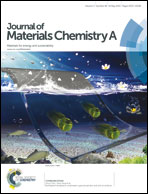Porous carbon sphere anodes for enhanced lithium-ion storage
Abstract
Amorphous and turbostratic porous carbon spheres are synthesized through a template-free spray pyrolysis method. Anodes composed of these non-graphitic carbon spheres outperformed the commercial graphitic carbon anodes in rechargeable Li-ion batteries. A discharge capacity of 378 mA h g−1, which is equivalent to the theoretical limit of 372 mA h g−1, is achieved at a current density of 0.1 C (37.2 mA g−1). At a higher charge–discharge rate of 1 C, electrochemically most active turbostratic carbon spheres exhibited a reversible specific capacity of 270 mA h g−1, which is 4-fold higher compared to those of commercial graphitic carbon anodes. After 100 charge–discharge cycles at current densities of 0.1 C and 1 C, carbon spheres retained stable specific capacities of 365 and 250 mA h g−1, respectively. Spectroscopic and microscopic investigation of porous carbon anodes after 100 galvanostatic cycles illustrated an excellent structural stability of turbostratic carbon spheres during the lithiation–delithiation process. The notably higher electrochemical performance of carbon spheres is explained by their disordered crystal structure and porosity, which resulted in lower impedance and superior rate performance. This study demonstrates porous turbostratic carbon spheres having a higher charge potential and sloping profile as promising anodes for rechargeable Li-ion batteries.


 Please wait while we load your content...
Please wait while we load your content...